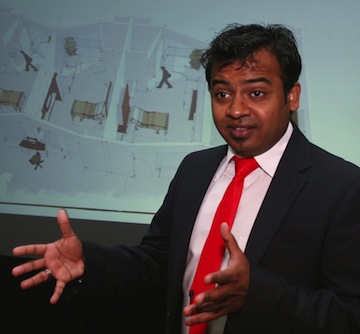Houston-based WHR Architects has named Lia Rodi, AIA, LEED AP, as the new curator of the firm’s Tradewell Fellowship Program, now in its 15th year. A past Tradewell Fellow, Rodi’s first official duty was the announcement of the 2012 Fellow Akshay Sangolli.
“It’s an honor to assume responsibility for the Tradewell program,” said Rodi. “Fourteen years ago, my own year as a Tradewell Fellow under the guidance of Kirk Hamilton was the ideal preparation for my new role. My experience and work with other Tradewells over the years has provided a model that will help to be of the best possible service to the Fellowship as a leader and mentor.”
Although internships are a tradition in the architectural profession, there are still few fellowships that offer recent graduates a focused opportunity to gain experience working closely with senior firm leaders and significant interaction with clients. This year’s Fellow, Akshay Sangolli, pursued the Tradewell in recognition of its exceptional nature. “It is a unique opportunity that puts you at an entirely different level at the outset of your career,” said Sangolli. “The Tradewell Fellowship offers [a] perfect combination of professional guidance, academic realization, and hands-on learning.”
The year-long Tradewell Fellowship was established by David Watkins, FAIA, president and chairman of WHR Architects, along with Kirk Hamilton, FAIA, FACHA, EDAC, now a professor at Texas A&M University and associate director for the Center for Health Systems and Design, in honor of the late Gary Tradewell, a former vice president and medical planner at WHR. The fellowship focuses on building careers of aspiring healthcare architects. Each year the Tradewell Fellow is involved with clients in early master planning and design, with a particular focus on healing environments and collaborative design methods as part of their employment at WHR. In addition to working directly with senior medical planners on design projects, Fellows receive career guidance from leaders at WHR and a network of past Tradewell Fellows.
In addition to project assignments, the Fellow also receives a scholarship to attend a healthcare architecture conference, and the opportunity to attend in-house educational presentations. Other educational opportunities include: assisting with teaching a graduate-level course on health facility planning, design, and construction; participating in evidence-based design activities; and assisting members of the firm in authoring speeches, articles, or books.
Fellows are selected by the group of past Tradewells at WHR, based on the strength of their design portfolios, letters of recommendation, and essays describing their accomplishments and career goals.
Sangolli, who began his fellowship in June, summarized his goals: “In the long term, I want explore how architecture can enhance human health, healing and well-being. I hope to participate in improving the quality of the built environment and its implications on human life around the world, especially in much-neglected developing nations.”
Related Stories
Cultural Facilities | Mar 26, 2024
Renovation restores century-old Brooklyn Paramount Theater to its original use
The renovation of the iconic Brooklyn Paramount Theater restored the building to its original purpose as a movie theater and music performance venue. Long Island University had acquired the venue in the 1960s and repurposed it as the school’s basketball court.
Adaptive Reuse | Mar 26, 2024
Adaptive Reuse Scorecard released to help developers assess project viability
Lamar Johnson Collaborative announced the debut of the firm’s Adaptive Reuse Scorecard, a proprietary methodology to quickly analyze the viability of converting buildings to other uses.
Security and Life Safety | Mar 26, 2024
Safeguarding our schools: Strategies to protect students and keep campuses safe
HMC Architects' PreK-12 Principal in Charge, Sherry Sajadpour, shares insights from school security experts and advisors on PreK-12 design strategies.
Green | Mar 25, 2024
Zero-carbon multifamily development designed for transactive energy
Living EmPower House, which is set to be the first zero-carbon, replicable, and equitable multifamily development designed for transactive energy, recently was awarded a $9 million Next EPIC Grant Construction Loan from the State of California.
Museums | Mar 25, 2024
Chrysler Museum of Art’s newly expanded Perry Glass Studio will display the art of glassmaking
In Norfolk, Va., the Chrysler Museum of Art’s Perry Glass Studio, an educational facility for glassmaking, will open a new addition in May. That will be followed by a renovation of the existing building scheduled for completion in December.
Sustainability | Mar 21, 2024
World’s first TRUE-certified building project completed in California
GENESIS Marina, an expansive laboratory and office campus in Brisbane, Calif., is the world’s first Total Resource Use and Efficiency (TRUE)-certified construction endeavor. The certification recognizes projects that achieve outstanding levels of resource efficiency through waste reduction, reuse, and recycling practices.
Office Buildings | Mar 21, 2024
Corporate carbon reduction pledges will have big impact on office market
Corporate carbon reduction commitments will have a significant impact on office leasing over the next few years. Businesses that have pledged to reduce their organization’s impact on climate change must ensure their next lease allows them to show material progress on their goals, according to a report by JLL.
Adaptive Reuse | Mar 21, 2024
Massachusetts launches program to spur office-to-residential conversions statewide
Massachusetts Gov. Maura Healey recently launched a program to help cities across the state identify underused office buildings that are best suited for residential conversions.
Legislation | Mar 21, 2024
Bill would mandate solar panels on public buildings in New York City
A recently introduced bill in the New York City Council would mandate solar panel installations on the roofs of all city-owned buildings. The legislation would require 100 MW of solar photovoltaic systems be installed on public buildings by the end of 2025.

















